Haute Couture Week in Paris is turning out to be something quite exceptional, dotted with special moments. From the outpouring of love for designer Giorgio Armani, who missed his own couture show under doctor's orders, to a masterful farewell from exiting creative director Demna at Balenciaga and a pared-back celebration of couture at Chanel.
Of the 28 designers showing collections, five were Arab this year – hailing from Lebanon, Saudi Arabia and, for the first time, Syria. For regional representation to take over nearly a fifth of the greatest stage in fashion is no small feat.
Day 4
Rami Al Ali
On July 10, Rami Al Ali became the first Syrian designer to join the official haute couture calendar. For his debut in Paris – after a decade showing off-schedule – Al Ali presented Guardians of Light, a tribute to the endangered handicrafts of Syria.
Inspired by Ottoman-era courtyards, Al Azem Palace’s painted panels, the grandeur of Jami Al Darwishiyya, and the geometry of mosque tiles, Dubai-based Al Ali distilled Syrian heritage into a collection defined by lightness and restraint. In a palette of cream, oat, bone, ash, gold and blue, he offered a plisse dress etched with mashrabiya patterns, a bell-skirted bone gown, and golden sheaths echoing Aghabani embroidery. A floating corset in golden threads crowned a gossamer chiffon gown.
His signature sculptural flourishes appeared as ripple-edged ruffs, cream folds unfurling like paper, and architectural arcs framing the face. Soft pleats in eau de nil and latte lent elegance in motion.
Al Ali’s haute couture debut honours his roots and elevates them to fashion’s highest stage. It was a moment 10 years in the making and well worth the wait. Read the full review here.
Day 3
Georges Chakra
Showing off-schedule, Lebanese designer Georges Chakra delivered a show centred on quietness.
This was a collection built around the studied calm of a finessed silhouette. It opened with an elegant black velvet dress topped with an embroidered taffeta overskirt, followed by a drop-waisted lace number beneath a skirt of ribbons and feathers.
A chartreuse gown curved around the body, its soft chiffon folds framing the shoulders. A sleek, all-red look – perfectly fitted from neck to floor – was softened by an arc of tufted chiffon cascading from shoulder to hem. Another red dress featured a beaded honeycomb construction and a deeply sensual neckline.
A mulberry velvet gown was wrapped in whirls of matching satin, while midnight blue sequins shimmered in a draped look that slipped coquettishly off one shoulder. Another in inky black velvet was quietly striking – one-shouldered, nipped at the waist. A sculptural chartreuse gown used quilted coils to encircle a simple column form.
Chakra’s craft shone brightest in a finale look: a champagne beaded bodice above a lace skirt that unfolded into taffeta at the knees, caught beneath a net layer trimmed with ostrich feathers. Elegant, showstopping and sublimely beautiful, this was Chakra at his quietly undisputed best.
Balenciaga

“This collection is the perfect way for me to finish my decade at Balenciaga,” said Demna of his final offering for the house.
That the designer chose to bow out with haute couture was no coincidence. He revived the maison’s couture division in 2021 after a 73-year hiatus, revealing his deep reverence for the founder – often described as the couturier’s couturier. “I leave satisfied with my attempts in the endless pursuit of impossible perfection, the defining ethos of Cristobal Balenciaga,” Demna said.
The intimate audience included former chief executive Cedric Charbit (now at Saint Laurent), singer Lorde, actresses Nicole Kidman and Naomi Watts (accompanied by her daughter Kai Schreiber), Michelle Yeoh, Kyle MacLachlan, and the house’s incoming creative director Pierpaolo Piccioli.
The collection was both a love letter to the brand and a reworking of Demna’s signature codes. It opened with monastic minimalism – a white tunic over a long white skirt, followed by a sharp-shouldered all-black ensemble. A sculpted red jacket and skirt peeled away into a mini-length hem at the back. Polka dots appeared on a tuxedo dress, followed by Isabelle Huppert in a chic but strict all-black trouser look.
Classics were subverted throughout: a trench became a floor-length dress; coats and men’s suiting were elongated into sweeping silhouettes; tailored forms gave way to Demna’s signature oversizing, with suits slipping off shoulders and trousers puddling around formal shoes.
There were back-to-front dresses, a bomber jacket in featherlight technical silk, and a puffer coat constructed without side seams. A biker jacket was rendered in luxurious cashmere and vicuña. Even a pair of corduroy trousers turned out to be made from 300km of tufted embroidery. Such is the house of Balenciaga.
Demna, a self-confessed devotee of Hollywood’s Golden Age, included a black sequinned Diva gown inspired by Marilyn Monroe and worn by Naomi Campbell. A corseted pink Debutante dress was cut from what show notes described as “the world’s lightest technical organza”. Kim Kardashian paid tribute to Elizabeth Taylor in a Cat on a Hot Tin Roof-style slip dress beneath a feathered coat engineered to mimic mink.
The finale look – an unsupported bridal gown in seamless white guipure lace – drew on millinery techniques to achieve its remarkable volume. Understated yet extraordinary, it was a fitting coda to Demna’s tenure.
As he moves on to Gucci and Piccioli steps into his role at Balenciaga, this final collection stands as a tribute to a clever, skilled and enigmatic designer.
Elie Saab

Elie Saab presented La Nouvelle Cour (The New Court) as a parade of muses inspired by the fashion aura of French queen Marie-Antoinette. But forget pastiche – this was a modern reimagining of regal elegance, fusing urbane attitude with effortless grace.
The show opened with model Lara Stone in a fitted black silk kick-flare dress, followed by a sharply tailored jacket paired with knickerbockers, complete with ties at the knee. A sleek velvet gown came next, its bodice constructed from knotted velvet ribbons. Muted, vintage-style florals appeared across a pale yellow gown, corset column dresses and sweeping oyster-toned looks.
Saab used the faded grandeur of eau de nil to lend an air of fragility, combining it with royal Rococo swirls and delicate bows to fasten bodices, secure tops and tie ribbons at the neck. Despite its historical references, this was no costume drama – it was the past, streamlined and redefined for today.
Much like Sofia Coppola reimagined Marie-Antoinette in her 2006 film of the same name, Saab has reconstructed her wardrobe for the modern woman. Models walked the runway with almost bare faces and loose, unstyled hair. It felt incredibly beautiful, edgy and modern.
Zuhair Murad

Zuhair Murad took a deep dive into the decadence of the 1920s and 1930s for his latest collection – an almost exclusively full-length ode to glamour.
The show opened with a fur-trimmed, old-gold 1930s-style jacket, followed by a flowing gown with Katharine Hepburn-esque squared shoulders and a jewel-encrusted midsection. Bias-cut skirts swirled under long, embellished house coats – some edged in beads, some not – while pleated and draped goddess dresses swept by in tones of peach, bone, bitter chocolate, slate grey and aubergine.
Hair was slicked back in soft Marcel waves, lips vampish and dark. Gowns were paired with long fur stoles, including one aubergine number where the stole looped into the hem – feeling like a nod to the artist Erte. A black velvet jacket dazzled with jewelled sleeves, while opera gloves shimmered with embroidered foliage. This was modern decadence, exquisitely executed.
Murad’s atelier was destroyed in the 2020 Beirut port explosion, and he has endured war and upheaval. His need to create beauty is hard-won and well-earned. His mastery of intricate patterning in sequins and beads is unrivalled; his gowns feel spun from silk and stardust.
For the finale, Murad veered delightfully away from silver screen nostalgia. His bride arrived in a bead-strewn golden mini dress – youthful, radiant, and full of optimism. A perfect ending note.
Day two
Ashi Studio

Over the past few seasons, Saudi-born couturier Mohammed Ashi has steadily carved out a place for himself as one of haute couture’s most compelling contemporary voices. With his sculptural compositions and architectural precision, he has captivated a global clientele including the likes of Beyonce, Zendaya and Queen Rania of Jordan – each drawn to the poetic drama of his designs. This season, with Cardi B seated front row, Ashi unveiled a collection that seamlessly fused artistic vision with technical precision.
Though the designer reportedly described the beginning of his creative process as disorienting, that sense of unease evolved into something profoundly captivating. His modern approach to couture once again came alive with striking cohesion, as sculptural silhouettes gave way to moments of fluidity and drapery, narrating a dialogue between traditional craftsmanship and contemporary expression.
While still unsure of the theme, Ashi began wandering around Parisian flea markets in search of inspiration. He unearthed fragments of history – time-worn textiles, porcelain charms and chinoiserie details, which were later reimagined into garments that nodded to France's Chateau de Chantilly and Victorian London. The collection, deliberately unnamed, unfolded like a personal journal.
Corsetry anchored many of the looks, at times visibly structured, at others concealed beneath layers of expertly draped fabric. These silhouettes lent a distinctly feminine edge to the otherwise architectural forms.
Ashi’s eye for construction also delivered sharply tailored jackets, an embroidered coatdress adorned with baroque embellishment, and an asymmetric trouser suit edged with spiralling fringe, each piece reinforcing his command of proportion, volume and balance.
Without the need for a title, the collection told a compelling story, inviting the audience into Ashi’s creative journey. It was a vivid reminder that couture, in his hands, is not only rooted in tradition, but also constantly reimagined for the modern world.
Giorgio Armani Prive
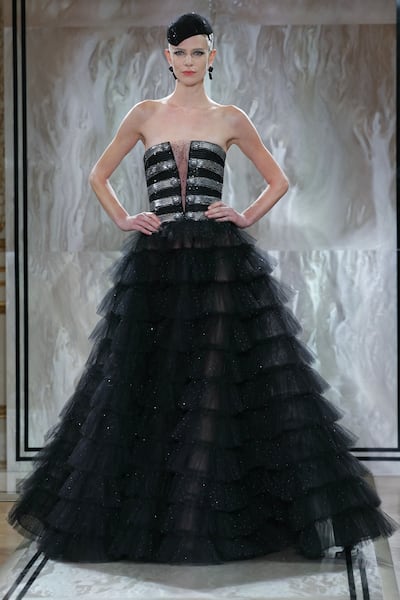
Giorgio Armani Prive’s autumn/winter 2025-2026 couture collection, Noir Seduisant (Seductive Black), is an ode to black, not as a singular colour, but as an entire spectrum of tones. For Armani, black represents clarity, structure and timeless sophistication. It’s a shade that conveys emotion with subtlety and strength.
While the famous nonagenarian designer was absent from Tuesday night’s show on doctor’s orders (his first time missing Paris Haute Couture Week in five decades, in addition to skipping his menswear show on June 21), his creative signature could be seen through every look as a sense of timelessness and understated elegance shone through.
The show began with delicate gowns accented by embroidered inserts, gradually giving way to a confident series of reimagined tuxedo jackets worn against bare skin, as well as sharply tailored blazers paired with crisp white shirts and slim trousers. Eveningwear took on a new dimension through long, flowing dresses punctuated by oversized bows, sheer plastrons and bracelet-like cuffs.
In many looks, black appeared in varying textures, from lacquered silk to deep velvet, each material offering its own depth and tone. Sequins, pavé crystals and glimmers of gold lent a soft luminosity, while other ensembles used black as a backdrop to showcase bursts of blue, magenta and metallic accents. Brief flashes of white, seen at collars and cuffs, sharpened the contrast.
There was a sense of structure to the looks, moving forward from the fluidity we have seen in the designer’s recent collections. Military-inspired jackets met velvet trousers, while sculpted gowns evoked statuary grace. Accessories – including berets, bow ties and tailored shirting – brought a masculine energy, continuing Armani’s exploration of gender-fluid tailoring.
With the designer recuperating, only days away from his 91st birthday, models closed the show alone in a poignant gesture that underscored the lasting power of his vision. Noir Seduisant is a reminder that Armani remains the master of understated elegance.
Day one
Iris van Herpen
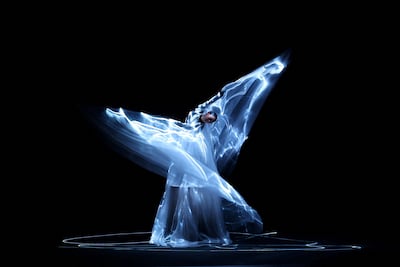
Dutch couturier Iris van Herpen, known for her experimental use of materials, opened her show with a look made from 250 million living algae bacteria. The result? An otherworldly glow with a bio-luminescent blue tint took over the runway.
It wasn't the only look that was wild and entrancing in equal measure; other cutting-edge fabrics included a metallic cloth so light it hung in the air like wisps of smoke around the model.
At a time fuelled by AI acceleration, the collection seems to theorise how our clothes might be on the verge of achieving sentience.
Schiaparelli
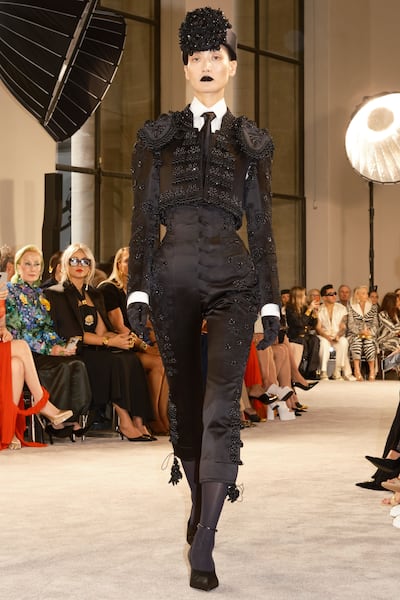
Under the helm of designer Daniel Roseberry, Schiaparelli's Back To The Future show examined how Parisian fashion reached new heights in the 1940s, just as the city fell to the Nazi occupation. The period forced designers, including Elsa Schiaparelli herself, to flee.
This was expressed as impeccable, two-piece tweedy suits, dresses cut and carved into the waist, or lavished with hundreds of embroidered eyes, as well as exquisite bull-fighter-style bolero jackets and cropped trousers.
Amid elegant coats trimmed with velvet and fur, and capes smothered in silver starburst embroidery, the collection's star appeared as a vivid, blood-red dress made entirely back-to-front.
Anatomically correct, the female form now ran down the model's spine and topped with a three-dimensional, beaded heart at the base of her neck. Thanks to some backstage mastery, said heart appeared to beat, pulsing hypnotically. Despite being surrounded by such handcrafted marvels, the effect brought us sharply back to, well, the heart of the story; the visceral terror of war.
Georges Hobeika
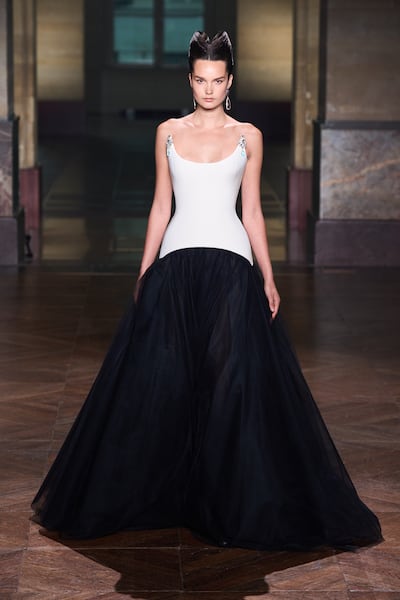
Lebanese couture house Georges Hobeika presented a show called The New Order, which unfolded in genteel elegance. Opening with a moulded corset over frilled bloomers, this was followed by another sculptural torso that was exaggerated around the hips, before slowly unfurling to the gossamer, flowing looks that Hobeika made his name on, scattered with beading and paillettes.
Shades shifted from bone white to nude, mocha and eventually to red, and finally to black. Designs ranged from flapper dresses, sheer bodice gowns and sharply pleated skirts to graceful off-the-shoulder looks scattered with fabric petals. Necklines were also a keen focus throughout, from square cuts to high and tight.
The closing bridal look was a silver beaded confection, so tightly worked that it looked as though the model's hips were covered in hammered silver. It served as an apt finale to a show that outlined precisely why Hobeika, and his son Jad, have been a constant presence at Paris Haute Couture Week since January 2017. Catering to women who desire a wardrobe of ravishingly beautiful cocktail dresses and gowns, spun from chiffon and featuring hundreds of hours of handwork, the looks brought to life by this father and son team are the stuff of dreams.
Rahul Mishra
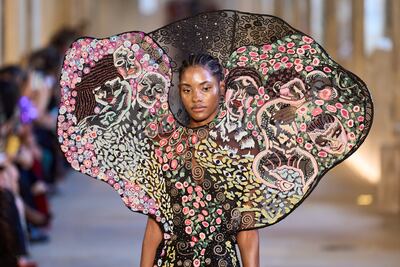
Becoming Love was the title of Rahul Mishra's show held inside a vaulted cathedral space in Paris. The collection explored Sufism and the notion of the seven stages of love, echoing attraction, infatuation, surrender, reverence, devotion, obsession and even death. In Mishra's hand, these became ephemeral constructions, such as the opening look that surrounded the model in golden curves.
Another look featured a sheer sheath, covered in delicate lotus flowers, while nods to artist Gustav Klimt appeared as swirls that adorned dresses and a billowing cape. With such a skilled atelier at his fingertips, Mishra is able to breathe life into the most lofty concepts, transforming each into a delicate, marvellous creation.



